brake light SAAB 9-3 2004 Owners Manual
[x] Cancel search | Manufacturer: SAAB, Model Year: 2004, Model line: 9-3, Model: SAAB 9-3 2004Pages: 288, PDF Size: 23.54 MB
Page 4 of 288
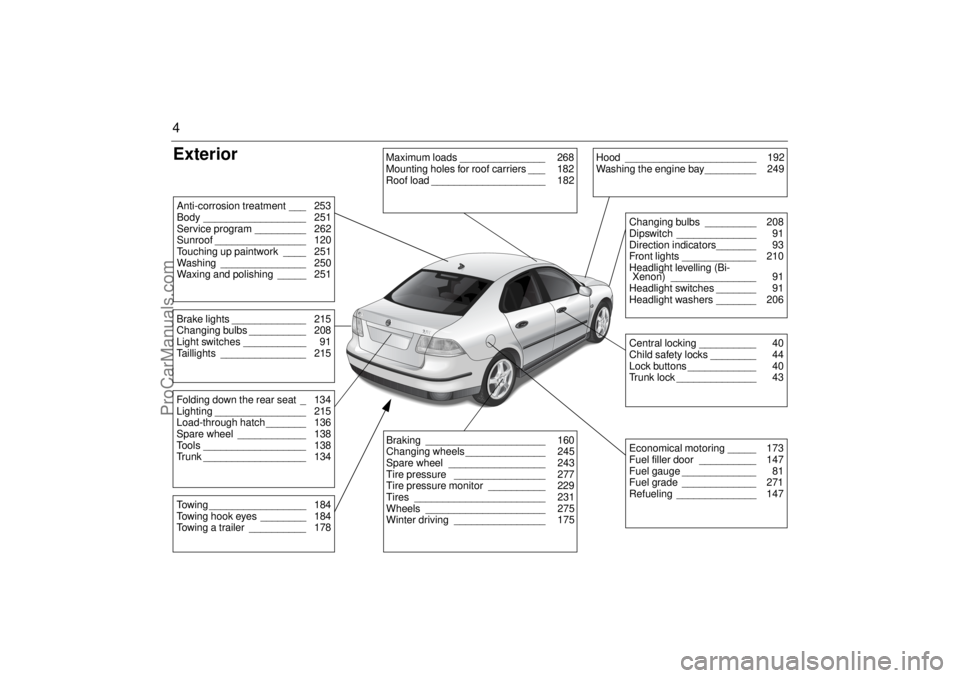
4ExteriorAnti-corrosion treatment ___ 253
Body __________________ 251
Service program _________ 262
Sunroof ________________ 120
Touching up paintwork ____ 251
Washing _______________ 250
Waxing and polishing _____ 251Brake lights _____________ 215
Changing bulbs __________ 208
Light switches ___________ 91
Taillights _______________ 215Towing _________________ 184
Towing hook eyes ________ 184
Towing a trailer __________ 178Folding down the rear seat _ 134
Lighting ________________ 215
Load-through hatch _______ 136
Spare wheel ____________ 138
Tools __________________ 138
Trunk __________________ 134
Maximum loads _______________ 268
Mounting holes for roof carriers ___ 182
Roof load ____________________ 182
Hood _______________________ 192
Washing the engine bay_________ 249
Central locking __________ 40
Child safety locks ________ 44
Lock buttons ____________ 40
Trunk lock ______________ 43Changing bulbs _________ 208
Dipswitch ______________ 91
Direction indicators_______ 93
Front lights _____________ 210
Headlight levelling (Bi-
Xenon) _______________ 91
Headlight switches _______ 91
Headlight washers _______ 206Economical motoring _____ 173
Fuel filler door __________ 147
Fuel gauge _____________ 81
Fuel grade _____________ 271
Refueling ______________ 147
Braking _____________________ 160
Changing wheels ______________ 245
Spare wheel _________________ 243
Tire pressure ________________ 277
Tire pressure monitor __________ 229
Tires _______________________ 231
Wheels _____________________ 275
Winter driving ________________ 175
ProCarManuals.com
Page 5 of 288
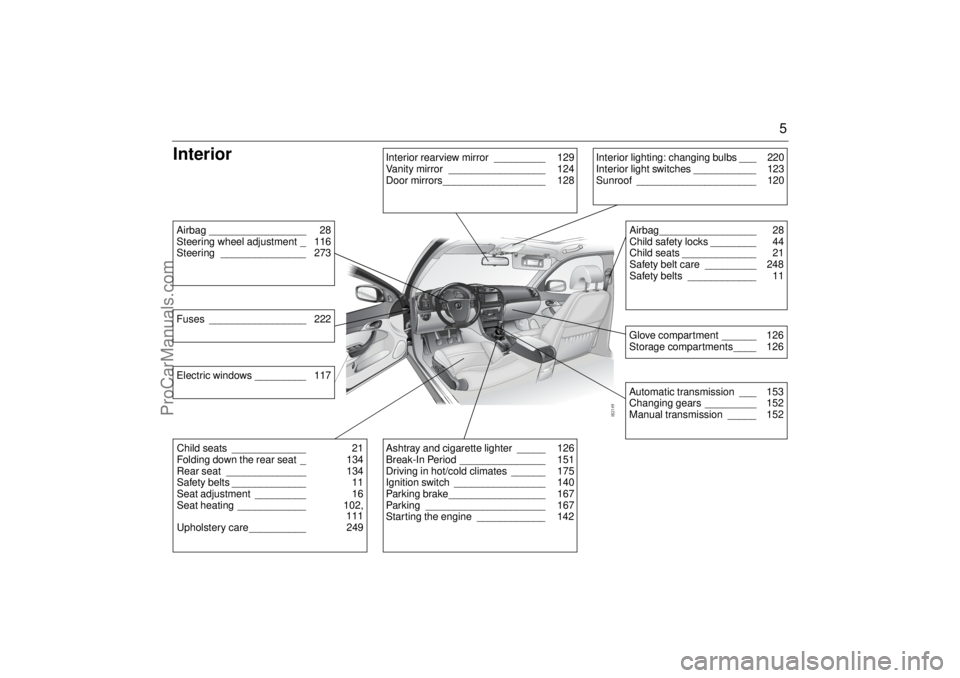
5
InteriorAirbag _________________ 28
Steering wheel adjustment _ 116
Steering _______________ 273
Interior rearview mirror _________ 129
Vanity mirror _________________ 124
Door mirrors__________________ 128
Airbag_________________ 28
Child safety locks ________ 44
Child seats _____________ 21
Safety belt care _________ 248
Safety belts ____________ 11Glove compartment ______ 126
Storage compartments____ 126Automatic transmission ___ 153
Changing gears _________ 152
Manual transmission _____ 152
Child seats _____________ 21
Folding down the rear seat _ 134
Rear seat ______________ 134
Safety belts _____________ 11
Seat adjustment _________ 16
Seat heating ____________ 102,
111
Upholstery care__________ 249
Interior lighting: changing bulbs ___ 220
Interior light switches ___________ 123
Sunroof _____________________ 120
Ashtray and cigarette lighter _____ 126
Break-In Period _______________ 151
Driving in hot/cold climates ______ 175
Ignition switch ________________ 140
Parking brake_________________ 167
Parking _____________________ 167
Starting the engine ____________ 142
Fuses _________________ 222Electric windows _________ 117
ProCarManuals.com
Page 8 of 288
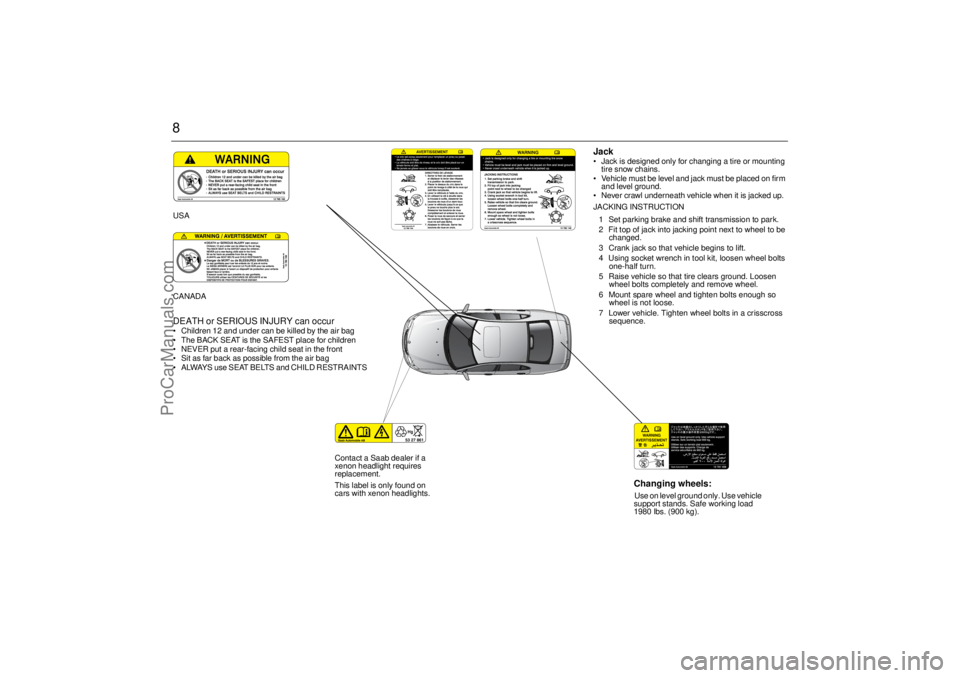
8
Changing wheels:Use on level ground only. Use vehicle
support stands. Safe working load
1980 lbs. (900 kg).
Contact a Saab dealer if a
xenon headlight requires
replacement.
This label is only found on
cars with xenon headlights.
DEATH or SERIOUS INJURY can occur Children 12 and under can be killed by the air bag
The BACK SEAT is the SAFEST place for children
NEVER put a rear-facing child seat in the front
Sit as far back as possible from the air bag
ALWAYS use SEAT BELTS and CHILD RESTRAINTSUSA
CANADA
Jack Jack is designed only for changing a tire or mounting
tire snow chains.
Vehicle must be level and jack must be placed on firm
and level ground.
Never crawl underneath vehicle when it is jacked up.
JACKING INSTRUCTION
1 Set parking brake and shift transmission to park.
2 Fit top of jack into jacking point next to wheel to be
changed.
3 Crank jack so that vehicle begins to lift.
4 Using socket wrench in tool kit, loosen wheel bolts
one-half turn.
5 Raise vehicle so that tire clears ground. Loosen
wheel bolts completely and remove wheel.
6 Mount spare wheel and tighten bolts enough so
wheel is not loose.
7 Lower vehicle. Tighten wheel bolts in a crisscross
sequence.
ProCarManuals.com
Page 9 of 288
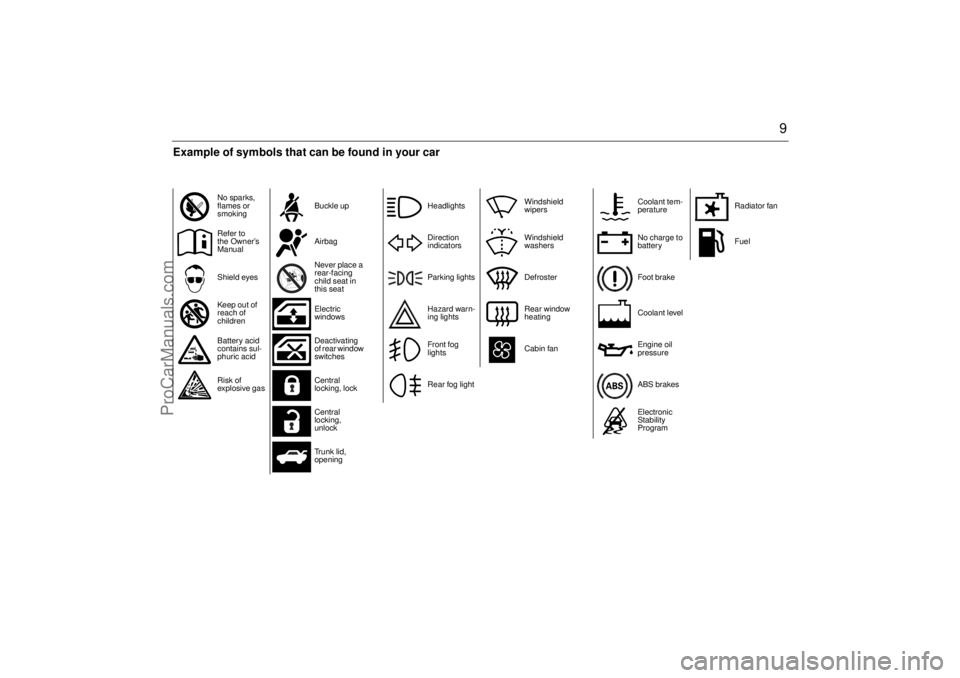
9
No sparks,
flames or
smokingBuckle up
Refer to
the Owner’s
ManualAirbag
Shield eyesNever place a
rear-facing
child seat in
this seat
Keep out of
reach of
childrenElectric
windows
Battery acid
contains sul-
phuric acidDeactivating
of rear window
switches
Risk of
explosive gasCentral
locking, lock
Central
locking,
unlock
Trunk lid,
opening
HeadlightsWindshield
wipers
Direction
indicatorsWindshield
washers
Parking lights Defroster
Hazard warn-
ing lightsRear window
heating
Front fog
lightsCabin fan
Rear fog light
Coolant tem-
peratureRadiator fan
No charge to
batteryFuel
Foot brake
Coolant level
Engine oil
pressure
ABS brakes
Electronic
Stability
Program
Example of symbols that can be found in your car
ProCarManuals.com
Page 74 of 288
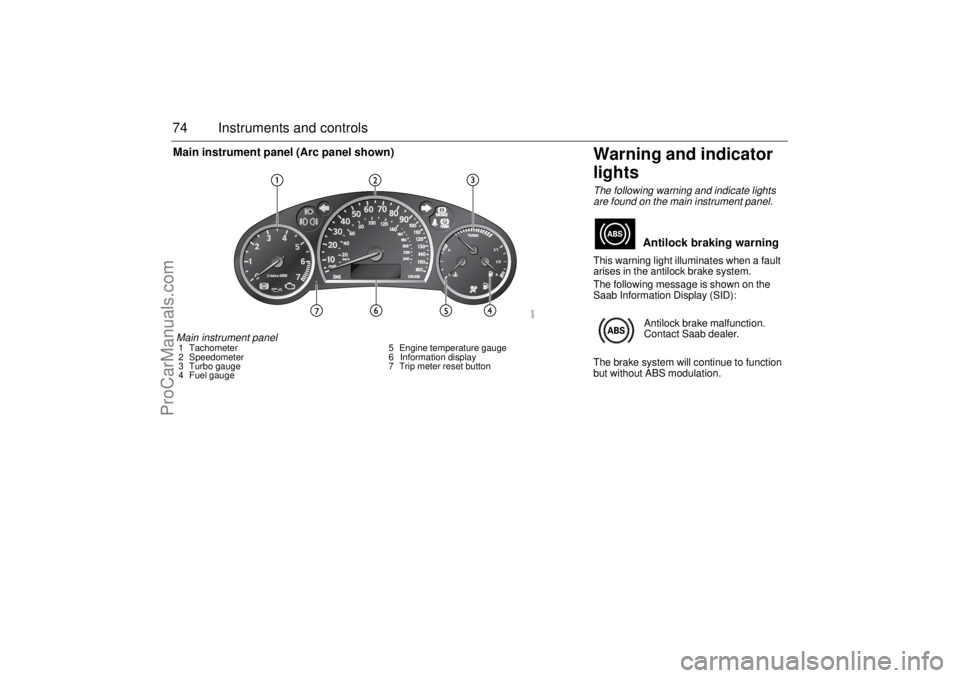
74 Instruments and controls
Warning and indicator
lightsThe following warning and indicate lights
are found on the main instrument panel.This warning light illuminates when a fault
arises in the antilock brake system.
The following message is shown on the
Saab Information Display (SID):
The brake system will continue to function
but without ABS modulation.
Antilock braking warningAntilock brake malfunction.
Contact Saab dealer.
Main instrument panel1 Tachometer
2 Speedometer
3 Turbo gauge
4 Fuel gauge5 Engine temperature gauge
6 Information display
7 Trip meter reset buttonMain instrument panel (Arc panel shown)
ProCarManuals.com
Page 75 of 288

75 Instruments and controls
This light will come on if the engine oil pres-
sure is too low. If the warning light flashes or
comes on while you are driving, stop imme-
diately in a safe place, switch off the engine
and check the oil level (see page 196).
The following message is shown on the
Saab Information Display (SID):This light indicates a malfunction in the fuel
or ignition system. The car may still be
driven with care but the performance of the
engine will be somewhat diminished (see
page 144).
The following message is shown on the
Saab Information Display (SID):
Warning, oil pressure
(engine oil)
NOTICE
Never drive the car when the oil pressure
warning lamp is on. Low oil pressure can
cause serious engine damage.
Oil pressure low.
Make a safe stop.
Turn off engine.
Engine malfunction
(CHECK ENGINE)
WARNING
An illuminated “Engine malfunction
(CHECK ENGINE)” indicator light indi-
cates an engine-related problem. While
your car may be able to be driven with the
“Engine malfunction (CHECK ENGINE)”
indicator light illuminated (limp-home
mode), you are advised to have your car
serviced at an authorized Saab dealer as
soon as possible.
Continued driving without this problem
being corrected might cause serious
further damage to your car and create
unsafe driving conditions. The operator
should be prepared to take action if such
unsafe conditions arise (e.g. brake
smoothly, engage neutral, stop in a suita-
ble place, switch off the engine, etc.)
Engine malfunction.
Contact Saab dealer.
NOTICEThe car should be checked immediately
at a Saab dealer to prevent more serious
faults from arising.
ProCarManuals.com
Page 76 of 288

76 Instruments and controlsThis light shows when the high beam is on
(see page 92).
This light indicates when the front fog lights
are on (see page 93).
The front fog lights are switched off auto-
matically when the engine is switched off.
When the fog lights are next needed, they
will have to be switched on manually.This light should come on briefly when you
turn the ignition key to ON. If it doesn´t come
on, have it fixed so it will be ready to warn
you if there is a problem. This light indicates
when the brake fluid level is too low (see
page 200).
The following message is shown on the
Saab Information Display (SID):For safety reasons, stop the car and check
the level of the brake fluid (see page 200).
If the level is normal, depress the brake
pedal firmly two or three times. Now check
the level again. If the level is still normal, you
may drive the car, with considerable cau-
tion, to the nearest Saab dealer to have the
brake system checked.
The brake system provides Electronic
Brakeforce Distribution (EBD). This distrib-
utes the brake pressure between the front
and rear wheels, in such a way as to achieve
optimum braking performance irrespective
of the car’s load.
If a fault arises in the EBD function, the ,
and lights will come on. Also, the fol-
lowing message will appear on the Saab
Information Display (SID):
If this is the case, drive carefully and contact
a Saab dealer as soon as possible. Refer to
Brake warning light on page 76, Antilock
braking warning on page 74 and TCS OFF
or ESP OFF indicator (certain variants only)
on page 82.
High beam Indicator
Front fog lights (option)
Brake warning lightBrake fluid level low.
Make a safe stop.
Contact Saab dealer.
WARNING
Never drive the car if these two lights
are on at the same time. Danger of
brake failure!
If the level of brake fluid in the reser-
voir is below the MIN mark, the vehicle
should be transported on a recovery
vehicle.
Have the brake system checked
immediately at a Saab dealer.
Brake malfunction.
Make a safe stop.
Contact Saab dealer.
ProCarManuals.com
Page 77 of 288
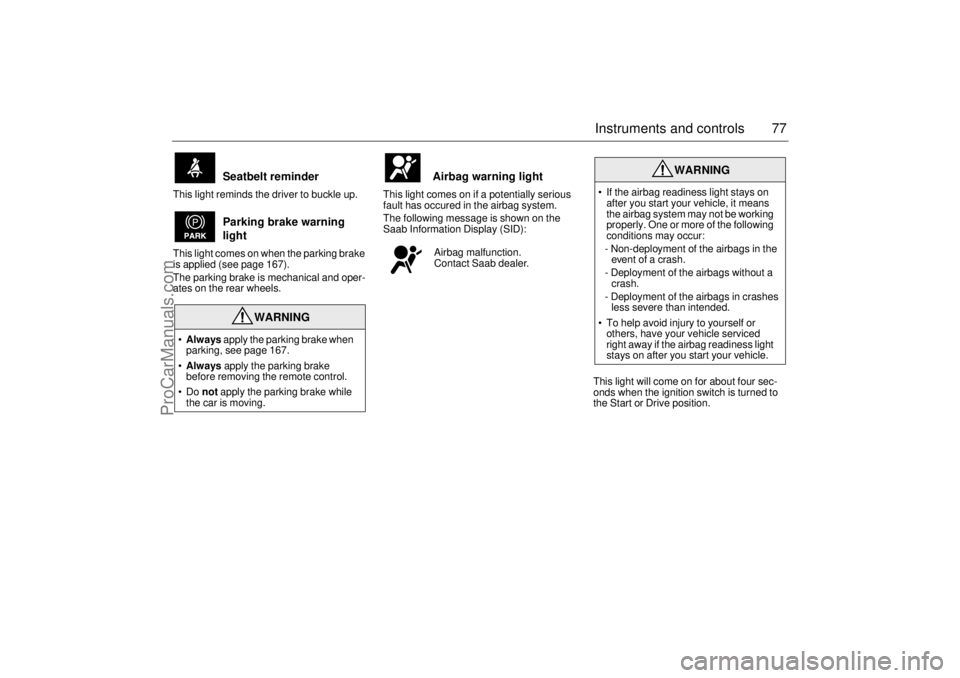
77 Instruments and controls
This light reminds the driver to buckle up.
This light comes on when the parking brake
is applied (see page 167).
The parking brake is mechanical and oper-
ates on the rear wheels.This light comes on if a potentially serious
fault has occured in the airbag system.
The following message is shown on the
Saab Information Display (SID):
This light will come on for about four sec-
onds when the ignition switch is turned to
the Start or Drive position.
Seatbelt reminder
Parking brake warning
light
WARNING
Always apply the parking brake when
parking, see page 167.
Always apply the parking brake
before removing the remote control.
Do not apply the parking brake while
the car is moving.
Airbag warning lightAirbag malfunction.
Contact Saab dealer.
WARNING
If the airbag readiness light stays on
after you start your vehicle, it means
the airbag system may not be working
properly. One or more of the following
conditions may occur:
- Non-deployment of the airbags in the
event of a crash.
- Deployment of the airbags without a
crash.
- Deployment of the airbags in crashes
less severe than intended.
To help avoid injury to yourself or
others, have your vehicle serviced
right away if the airbag readiness light
stays on after you start your vehicle.
ProCarManuals.com
Page 137 of 288
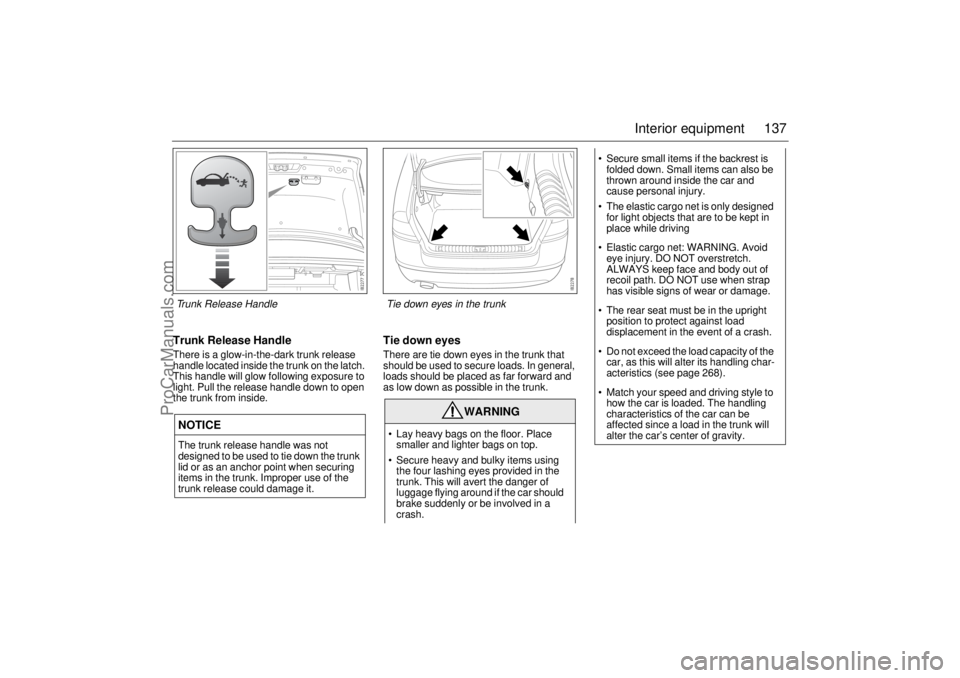
137 Interior equipment
Trunk Release HandleThere is a glow-in-the-dark trunk release
handle located inside the trunk on the latch.
This handle will glow following exposure to
light. Pull the release handle down to open
the trunk from inside.
Tie down eyesThere are tie down eyes in the trunk that
should be used to secure loads. In general,
loads should be placed as far forward and
as low down as possible in the trunk.
NOTICEThe trunk release handle was not
designed to be used to tie down the trunk
lid or as an anchor point when securing
items in the trunk. Improper use of the
trunk release could damage it.
WARNING
Lay heavy bags on the floor. Place
smaller and lighter bags on top.
Secure heavy and bulky items using
the four lashing eyes provided in the
trunk. This will avert the danger of
luggage flying around if the car should
brake suddenly or be involved in a
crash.
Secure small items if the backrest is
folded down. Small items can also be
thrown around inside the car and
cause personal injury.
The elastic cargo net is only designed
for light objects that are to be kept in
place while driving
Elastic cargo net: WARNING. Avoid
eye injury. DO NOT overstretch.
ALWAYS keep face and body out of
recoil path. DO NOT use when strap
has visible signs of wear or damage.
The rear seat must be in the upright
position to protect against load
displacement in the event of a crash.
Do not exceed the load capacity of the
car, as this will alter its handling char-
acteristics (see page 268).
Match your speed and driving style to
how the car is loaded. The handling
characteristics of the car can be
affected since a load in the trunk will
alter the car’s center of gravity.
Tie down eyes in the trunk
Trunk Release Handle
ProCarManuals.com
Page 143 of 288

143 Starting and driving
Starting the engineAvoid racing the engine or loading it heavily
before it has warmed up. Do not drive away
before the warning and indicator lights have
gone out.
The engine has an automatic choke and
should be started as follows:
Cars with manual transmission
To start the engine the clutch pedal must
be fully depressed.
1 Make sure the parking brake is applied.
2 Depress the clutch pedal but do not
touch the accelerator.
3 Start the engine. Let the remote control
spring back as soon as the engine has
started and is running smoothly.
Allow the engine to idle for about
10 seconds. Do not apply full throttle for at
least 3 minutes after starting.Cars with automatic transmission
The selector lever must be in the P or N
position.
1 The selector lever must be in the P or N
position.
2 Keep your foot on the brake pedal.
Note! Once the engine has started, the
brake pedal will sink. This is perfectly
normal.
3 Start the engine. Let the remote control
spring back as soon as the engine has
started and is running smoothly.
Allow the engine to idle for about
10 seconds. Do not apply full throttle for at
least 3 minutes after starting.
Useful tips on starting the engineIf the engine has failed to start after several
attempts in very cold weather, proceed as
follows:
1 Turn the ignition switch to ON (it is
essential that you turn the ignition to
ON before depressing the accelerator).
2 Press the accelerator to the floor and run
the starter motor for 5-10 seconds. This
will prevent the engine being flooded
(fully depressed accelerator cuts off the
fuel supply).
3 Now start the engine in the normal way
- do not touch the accelerator.
If the engine stalls immediately after starting
(e.g. if the clutch was released too quickly),
do not touch the accelerator when restarting
the engine.
ProCarManuals.com